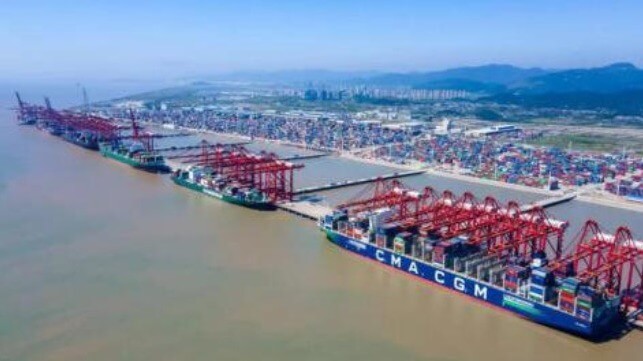Sea-Intelligence: Overcapacity Could Trigger Container Price War

During the surge in container shipments, the carriers had every possible vessel sailing to maximize capacity on their routes. Now as volumes have slackened and spot freight rates tumbled there have been forecasts that carriers would begin dramatically cutting back on capacity by blanking sailings and laying up vessels for an extended period. The analysts at Sea-Intelligence, however, are warning that the cuts may not be coming quickly enough laying the groundwork for even more competition on price as volume falls during and after Chinese New Year.
Traditionally, the period around Chinese New Year Sea-Intelligence notes sees a production slowdown in Asia. The shipping lines blank sailings in order to bring supply in line with demand. The industry has already begun blanking sailings with the expectation that it will continue and likely increase in the coming weeks. The Port of Los Angeles for example was forecasting at least 11 blanked sailings to the port during December following 13 blanked sailings in November.
Chinese New Year is also earlier in 2023. The holiday is January 22 with China and Vietnam having an official week-long holiday running till January 27. Normally there is a rush to move goods in the weeks before the holiday while many companies slow operations and reduce capacity for several weeks around and after the holiday.
Jeremy Nixon, CEO of One Network Express, one of the leading Pacific carriers, said his firm was expecting that factories might take as many as four or five weeks off in January and February around the holiday. He said his firm was expecting carriers to reduce capacity by as much as 50 percent on some routes and slowly build it back with the seasonality pick up in March and later.
Alphaliner at the beginning of December reported that approximately 1.4 million TEU of capacity has already been idled or a total of 261 ships. That represents little more than five percent of global capacity, but some analysts have forecast that during the first quarter idle capacity could rise to 2 million TEU or more.
“In 2020, we saw an extension of Chinese New Year (CNY) due to the Covid outbreak, while in both 2021 and 2022 the shipping lines kept capacity high in order to cater to the high demand levels,” says Alan Murphy, CEO of Sea-Intelligence. “Given that demand growth has now stagnated, and freight rates are still dropping, it would make sense for the shipping lines to blank additional capacity during CNY 2023 to try and stem the bleeding freight rates.”
Murphy highlights that while the expectation is for further capacity cuts based on the volume declines and dropping rates, it is not the case.
“When we compare 2023 with both 2019 and the average capacity growth rate of 2015-2019, we see an extraordinary increase in deployed capacity,” said Murphy. According to Sea-Intelligence’s analysis of the current schedules. Asia-North America West Coast is seeing capacity growth of 35 to 38 percent, Asia-North America East Coast of a staggering 57 to 59 percent, and Asia-North Europe of 28 to 42 percent. Asia-Mediterranean is the only trade lane that is closer to the pre-pandemic levels Sea-Intelligence notes.
“This development is quite concerning, as despite falling demand, deployed capacity during CNY 2023 is slated to be higher than the deployed capacity in 2021, where demand was absolutely surging. If demand continues to be sluggish, or outright contracts, given these capacity levels, freight rates will continue to tumble,” predicts Murphy.
With the shipping lines sitting on piles of cash, further helped by a highly profitable Q3, Sea-Intelligence speculates that the industry might end up in a situation where there is another price war, reminiscent of the 2015-2016 price war in container shipping.
